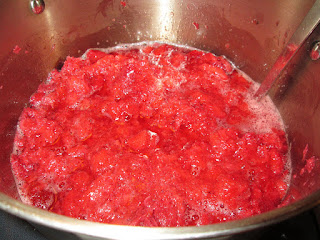Commercial pectin comes in either powder or liquid form. There are several brands out there to choose from. What I am going to teach you how to make is a liquid pectin made from apples.
If you happen to have a Crab Apple Tree or any other Apple Tree in your yard, then you are blessed. Crab Apples make great pectin but any of the little green apples will do good. Use them while they are small.
Wash your apples by filling the sink with water and adding one cup of vinegar. Let them sit about ten or fifteen minutes.
Fill a large stainless steel pot with the apples. If they are larger than crab apples then cut them in half. Add just enough water to cover them. I didn't take enough pictures, so I will update and do more with my next batch.
Cook them until your apples are completely soft and the skins are bursting open. It will look like a pot of mush, but don't mash them up like apple sauce. I usually cook them about an hour.
Now you are almost done. Line a colander with several layers of cheese cloth or use a jelly bag if you have one. Put your apples in this to strain the liquid. Let it sit and drip for several hours or even overnight.
You will be tempted to stir it, but DON'T do that. You just want the pure pectin to drip through.
Wait until your pectin is completely cool and then test it's strength.
Test your pectin to see how good it's jelling strength is by pouring a little rubbing alcohol in a small bowl. Put a spoonful of your pectin in the alcohol. Wait one minute and then dip it out with a fork. It should cling to the fork like a gel.
Toss the alcohol..Do not taste this...it's for testing the strength of your pectin
If it doesn't cling to the fork then put it back in a pot and boil to reduce it some more. Cool and test again.
You can use this pectin to make jams or jellies right away or store it in your refrigerator for a couple of weeks.
It usually take about 1/4 cup of pectin for every cup of fruit you are using. For example if you are making a batch of jam that calls for 5 cups of crushed berries then you should use at least 1 1/4 cup of the homemade pectin and at least 6 to 7 cups of sugar.
Always add 1/4 cup of Lemon Juice when using home made pectin, it will help it set better.
Cook your jam until you see it forms foam and test it using the cold spoon test. Dip a spoonful of jam and hold an ice cube to the bottom of the spoon until the jam cools. If it sets then your are ready to fill your jars and process.
Making jam or jelly using home made pectin is something you will have to practice and not every batch will turn out right. If it doesn't set the first time, you can either add a little more sugar and pectin and reboil or use it for syrup on ice cream.
The downside to making and using your own pectin.
- There are no tested recipes to tell you exactly how much of anything to use.
- You usually end up using more sugar than you normally would using commercial pectin.
- It takes much longer to cook and you will lose some of the flavor from the fruit.
The upside to making and using your own pectin.
- You are getting all natural ingredients
- You save money
- You have the pleasure of knowing it's truly homemade
- Most commercial pectins are made from GMO products and you want to stay away from that when possible.







